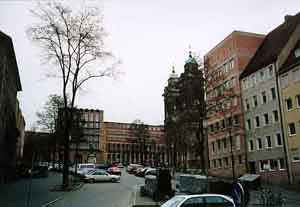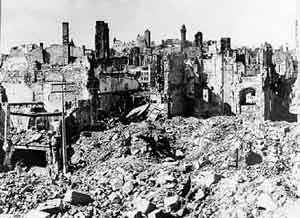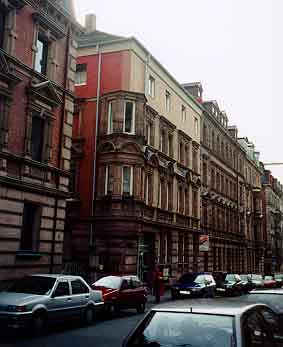Despite my wife's many trips to visit relatives in Nuremberg, I have always found
some excuse to take a pass on anticipated jet lag, boring waits in custom lines and
other less exciting aspects of overseas travel. Reality hit this year, while looking
out of a side window of our Lufthansa Fokker turboprop on a final approach into
Nuremberg. Reenactors tend to be dreamers and this one is no exception having
visualized Adolf Galland in his Messerschmitt BF109 accompanying us slightly
above our starboard wing tip over the German countryside.
Nuremberg is located in the southeast corner of Germany near the Czech boarder.
Nuremberg was the home of several emperors from 1050-1400. An industrial
center, Nuremberg was the site of the first steam powered railway in 1835. In
1933 Adolf Hitler adopted Nuremberg as the center of the National Socialist Party
Activities. Most of the historical part of the city was destroyed by allied bombers
during World War II. The present population is about a half million people.
Having relatives at a foreign country destination facilitates the learning of the
local culture, the habits and opinions of the people native to that country.
Preparation for the trip involved obtaining WWII photos of the town so
comparisons could be made, then and now. It was not surprising to find a lack of
monuments to WWII since the Germans were not the victors.
Shown below and to the left is a view of the Zeppelin grandstand at Soldiers' field in 1939, the site of
many National Socialist Party rallies. Shown below and to the right Soldiers’ field in 1998, now
a racetrack. Most WWII historians have seen the film footage of the large
swastika sculpture exploding after the defeat of German forces. The columns
around the structure were removed after the war.


Zeppelin Grandstand, site of Nazi party rallies, 1939, and in 1998, now a race track
Shown below is
a monument to the war in front of Soldiers’ Field, the location of many of
the large National Socialist rallies before the war. The monument contained many
broken parts of guns and munitions symbolizing the abandonment of war as a
means of settling national conflicts.

Monument at Soldiers' Field
The photos below are a view of the city looking south in 1945 after bombing by British
bombers and approximately the same angle in 1998. The
church at the right and the tower in the upper middle of the photo were used as
reference points.


Nuremberg looking south, 1945 / Nuremberg looking south, 1998
Talking with relatives revealed that many Germans that were
alive during the war understood the reasoning of the Allies bombing military
targets but resented the bombing of civilian targets. The younger generations have
little knowledge of WWII since many of their elders would not discuss details of
their experiences during the war. My sister-in-law's father-in-law was a German
officer during WWII, surviving the defeat at Stalingrad and the Battle of the
Bulge. He was surprised to learn of reenactors in the US portraying German
soldiers since the exploits of the Wehrmacht were usually not discussed openly in
Germany. While browsing through a German bookstore, I spied one of the few
adventure books about World War II. On the front outer jacket there was an
artist's rendition of a B17 Flying Fortress riddled with bullet holes having been
attacked by a Messerschmitt 262 jet fighter. A little bias in the rendition I'm sure.
A side trip was made to the German Technical Museum in Munich, a fabulous
museum with many exhibits including a German submarine, many WWII vintage
aircraft and automobiles. The photo below is a view of the ME262 and Komet ME163
fighter aircraft. There were virtually no WWII German armored vehicles on
display, the only disappointing aspect of the museum exhibits.

ME262 and ME163
Memories of the trip are many, but a few thoughts stand out. The younger
Germans we met have little knowledge or interest in the history of the Wehrmacht
in WWII. Most likely as a result of the defeat, older Germans are not transferring
the war experiences to the younger generations. Unlike efforts in the US to keep
the memory alive by documenting the experiences of WWII veterans, little is
being done in Germany, the likely consequence of which is a loss of historical
perspective as the generation passes on.


Historical section of Nuremberg shortly after the January 2, 1945 air raid by British bombers and in 1998


Looking north from the center of Nuremberg toward the imperial fortress, 1945 and in 1998


St. Lorenz Church, center of town, looking east on Karolinenstrasse, 1945, and in 1998


Imperial fortress, August 1942, and in 1998

Typical row of homes in suburban Nuremberg. Notice the center building with different architectural design on the top floor. The top apartment was repaired after being destroyed during bombing in WWII.
 BACK TO ROBERTS ARMORY HOME PAGE
BACK TO ROBERTS ARMORY HOME PAGE


Zeppelin Grandstand, site of Nazi party rallies, 1939, and in 1998, now a race track

Monument at Soldiers' Field


Nuremberg looking south, 1945 / Nuremberg looking south, 1998
Talking with relatives revealed that many Germans that were
alive during the war understood the reasoning of the Allies bombing military
targets but resented the bombing of civilian targets. The younger generations have
little knowledge of WWII since many of their elders would not discuss details of
their experiences during the war. My sister-in-law's father-in-law was a German
officer during WWII, surviving the defeat at Stalingrad and the Battle of the
Bulge. He was surprised to learn of reenactors in the US portraying German
soldiers since the exploits of the Wehrmacht were usually not discussed openly in
Germany. While browsing through a German bookstore, I spied one of the few
adventure books about World War II. On the front outer jacket there was an
artist's rendition of a B17 Flying Fortress riddled with bullet holes having been
attacked by a Messerschmitt 262 jet fighter. A little bias in the rendition I'm sure.
A side trip was made to the German Technical Museum in Munich, a fabulous
museum with many exhibits including a German submarine, many WWII vintage
aircraft and automobiles. The photo below is a view of the ME262 and Komet ME163
fighter aircraft. There were virtually no WWII German armored vehicles on
display, the only disappointing aspect of the museum exhibits.

ME262 and ME163
Memories of the trip are many, but a few thoughts stand out. The younger
Germans we met have little knowledge or interest in the history of the Wehrmacht
in WWII. Most likely as a result of the defeat, older Germans are not transferring
the war experiences to the younger generations. Unlike efforts in the US to keep
the memory alive by documenting the experiences of WWII veterans, little is
being done in Germany, the likely consequence of which is a loss of historical
perspective as the generation passes on.


Historical section of Nuremberg shortly after the January 2, 1945 air raid by British bombers and in 1998


Looking north from the center of Nuremberg toward the imperial fortress, 1945 and in 1998


St. Lorenz Church, center of town, looking east on Karolinenstrasse, 1945, and in 1998


Imperial fortress, August 1942, and in 1998

Typical row of homes in suburban Nuremberg. Notice the center building with different architectural design on the top floor. The top apartment was repaired after being destroyed during bombing in WWII.
 BACK TO ROBERTS ARMORY HOME PAGE
BACK TO ROBERTS ARMORY HOME PAGE

ME262 and ME163


Historical section of Nuremberg shortly after the January 2, 1945 air raid by British bombers and in 1998


Looking north from the center of Nuremberg toward the imperial fortress, 1945 and in 1998


St. Lorenz Church, center of town, looking east on Karolinenstrasse, 1945, and in 1998


Imperial fortress, August 1942, and in 1998
